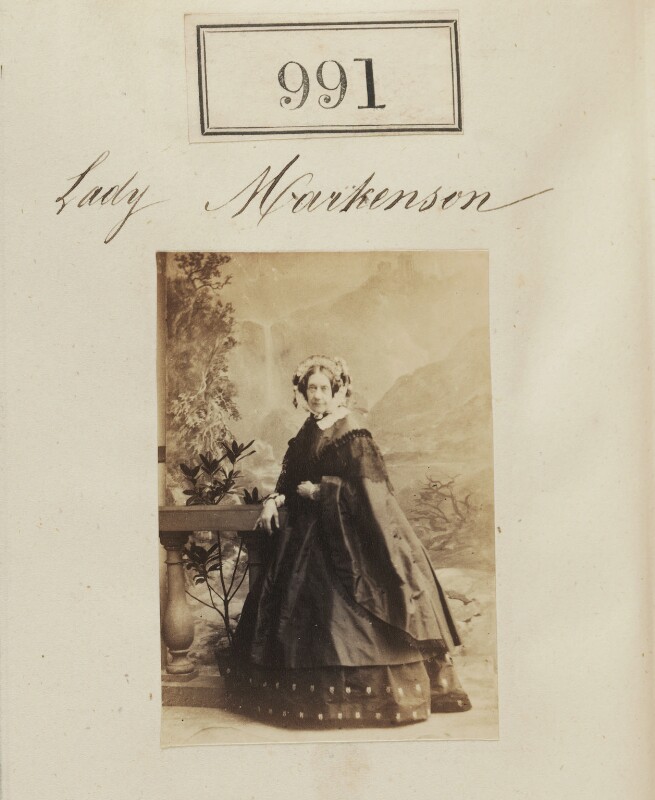
‘The light of science’, a satirical cartoon by Henry T De la Beche, 1832, depicting Charlotte Murchinson
By the early nineteenth century, the study of the Earth became central to the economic and cultural life of Great Britain. Due to the informal character of the early British geology, women were free to take part in collecting fossils and mineral specimens, and they were allowed to attend lectures, although they were still barred from membership in scientific societies. Early female scientists were often born into influential families, like Mary Lyell, the daughter of the geologist Leonard Horner. Althought Barbara Hastings (1810-1858) and Etheldred Benett (1776–1845) published their works independently, the prevailing pattern was formed by women who have worked in the field but acted as assistants to father, husband, brother, or other male geologist that were no relatives. In these cases, the publication of their findings was not part of accepted females activy, and their contribution is often completely concealed under the name of someone else.
Charlotte Murchison (neé Hugonin) was born on 18 April 1788 in Hampshire, England. When she met her future husband Roderick Murchison, she was a well-educated woman with great interest in science and he was a cavalry officer in the Dragoons who was more interested in horses and dogs than in Geology. The couple married on August 29, 1815. The first few years of their marriage they travelled extensively in the Continent. In Italy they became friends with Mary Somerville, the “Queen of Nineteenth Century Science.” In her autobiography, Mary Somerville wrote about Charlotte: “Mrs Murchison was an amiable accomplished woman, drew prettily and what was rare at the time she had studied science, especially geology and it was chiefly owing to her example that her husband turned his mind to those pursuits in which he afterwards obtained such distinction.”

Charlotte (née Hugonin), Lady Murchison by Camille Silvy, albumen print, 1860, NPG Ax50535
© National Portrait Gallery, London
In 1824 the couple moved to London where they began to attend lectures on geology and chemistry. A year later, Roderick Murchison read his first paper to the Geological Society. The same year, the couple explored the southern coast of England. In Lyme Regis, they became friends with Mary Anning, and when Mary visited London in July 1829, she stayed with the Murchisons. In a letter to Charlotte Murchison, dated October 11, 1833, Mary writes about the death of her beloved dog Tray which was killed in a landslide: “I would have answered your kind letter by the return of post, if I had been able. Perhaps you will laugh when I say that the death of my old faithful dog quite upset me, the Cliff fell upon him and killed him in a moment before my eyes, and close to my feet, it was but a moment between me and the same fate”.
In 1826, the couple traveled to the coast of Yorkshire. The fossils collected by Charlote were later described by James de Carle Sowerby in the “Mineral Conchology of Great Britain”. In 1827 Sowerby named an ammonite in her honor: Ammonites murchinsoniae. Willian Buckland also used Charlotte’s collection of fossils to illustrate his “Geology and Mineralogy Considered with References to Natural Theology.”

One of Charlotte Murchison’s illustrations for: Murchison, Roderick Impey. The Silurian system (Image: archive.org)
In 1828, Charlotte and her husband joined Charles Lyell on a long journey around Europe. In his notes Charles Lyell praised the active participation of Charlotte: “Mrs . M. is very diligent , sketching, labelling specimens & making out shells in which last she is an invaluable assistant.” Nevertheless, in the summer of 1832, Lyell refused to let women attend his lectures in Geology at Kings College London because he thought that women in a classroom would be “unacademical”. Charlotte and Mary Somerville were among the women who insisted on being allowed to attend the lectures. Some days later, in a letter to his long time friend William Whewell, Mary Somerville wrote: ‘It is decided by the Council of the University that ladies are to be admitted to the whole course, so you can see what in[va]sions we are making on the laws of learned societies, reform is nothing to it”
It was suggested that Lyell’s capitulation was related to Charlotte’s presence among the crowd. In 1834, William Whewell welcomed scientific women to the third meeting of the British Association. In an invitation addressed to Mary Somerville, he wrote: “I expect Mrs. Buckland and Mrs. Murchinson and several other ladies…”
Charlotte continued sketching the cliffs and collecting fossils but due to her health issues, she was not abble to join her husband in many of his late travels. By the 1860s Charlotte’s health has deteriorated. She died on 9 February 1869 at her home in Belgrave Square, London.
References:
Kölbl-Ebert, Martina (1997). “Charlotte Murchison (Née Hugonin) 1788-1869”. Earth Sciences History (History of Earth Sciences Society) 16 (1): 39–43 https://doi.org/10.17704/eshi.16.1.97014235w8u4k414
Kölbl-Ebert, M. (2007). The geological travels of Charles Lyell, Charlotte Murchison and Roderick Impey Murchison in France and northern Italy (1828). Geological Society, London, Special Publications, 287(1), 109–117. doi:10.1144/sp287.9
EYLES, V. A. (1971). Roderick Murchison, Geologist and Promoter of Science. Nature, 234(5329), 387–389. doi:10.1038/234387a0
Pingback: Charlotte Murchison – Melissa Highton